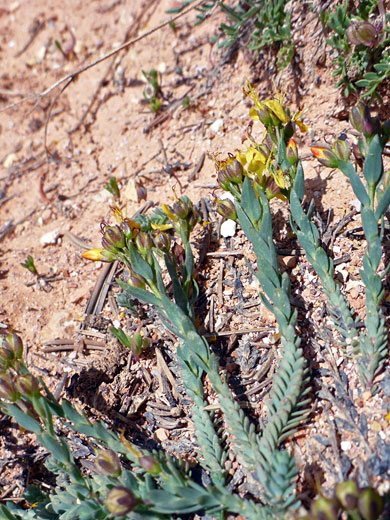Common name:
King's yellow flax
Family:
Scientific name:
Linum kingii
Main flower color:
Range:
From eastern Nevada to Wyoming and northwest Colorado
Height:
Up to 12 inches
Habitat:
Open flats and slopes, usually barren, rocky or clayish places, from 5,000 to 11,000 feet
Leaves:
Mostly alternate, narrowly lanceolate, up to 1 inch long
Season:
May to August
Linum kingii, a perennial, is a low-growing, somewhat variable species that branches freely and has overlapping, tightly clustered leaves; it is found in medium to high elevation areas from eastern Nevada to southwestern Wyoming.
All plant parts are hairless. Leaves and stems are greyish-green (glaucous). Stems branch from the base and are held a range of angles, from erect to prostrate. Leaves may be opposite towards the base but are otherwise alternate; they are narrow, with a single, faint vein, and are closely-spaced.
Flowers are arranged in a compact panicle. The five sepals are purplish-green, pointed but not bristle-tipped, and lined by a few tiny glandular teeth, while the five petals are all-yellow, lacking any darker marks. Petals are markedly narrower at the base. The five styles are not fused, and are topped by yellow, head-shaped stigmas. Anthers are relatively large.
All plant parts are hairless. Leaves and stems are greyish-green (glaucous). Stems branch from the base and are held a range of angles, from erect to prostrate. Leaves may be opposite towards the base but are otherwise alternate; they are narrow, with a single, faint vein, and are closely-spaced.
Flowers are arranged in a compact panicle. The five sepals are purplish-green, pointed but not bristle-tipped, and lined by a few tiny glandular teeth, while the five petals are all-yellow, lacking any darker marks. Petals are markedly narrower at the base. The five styles are not fused, and are topped by yellow, head-shaped stigmas. Anthers are relatively large.
All Contents © Copyright The American Southwest | Comments and Questions | Contribute | Site Map





